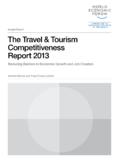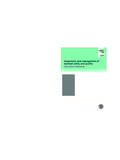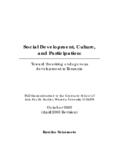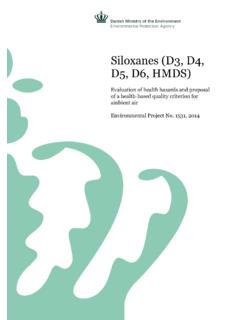Transcription of Technical and Socio-Economic Characteristics of …
1 FIAO/C1111 (En). FAO. Fisheries and Aquaculture Circular ISSN 2070-6065. Technical AND Socio-Economic Characteristics OF. SMALL-SCALE coastal fishing communities , AND. opportunities FOR POVERTY ALLEVIATION AND EMPOWERMENT. Cover: Photo by SV Siar (FAO). fishing household removing catch from the net in Gujarat coast, India. FAO Fisheries and Aquaculture Circular FIAO/C1111 (En). Technical AND Socio-Economic Characteristics OF. SMALL-SCALE coastal fishing communities , AND. opportunities FOR POVERTY ALLEVIATION AND EMPOWERMENT. by Uwe Tietze Consultant Olympia, Washington United States of America FOOD AND AGRICULTURE ORGANIZATION OF THE UNITED NATIONS. Rome, 2016. The designations employed and the presentation of material in this information product do not imply the expression of any opinion whatsoever on the part of the Food and Agriculture Organization of the United Nations (FAO) concerning the legal or development status of any country, territory, city or area or of its authorities, or concerning the delimitation of its frontiers or boundaries.
2 The mention of specific companies or products of manufacturers, whether or not these have been patented, does not imply that these have been endorsed or recommended by FAO in preference to others of a similar nature that are not mentioned. The views expressed in this information product are those of the author(s) and do not necessarily reflect the views or policies of FAO. ISBN 978-92-5-109230-9. FAO, 2016. FAO encourages the use, reproduction and dissemination of material in this information product. Except where otherwise indicated, material may be copied, downloaded and printed for private study, research and teaching purposes, or for use in non-commercial products or services, provided that appropriate acknowledgement of FAO as the source and copyright holder is given and that FAO's endorsement of users' views, products or services is not implied in any way. All requests for translation and adaptation rights, and for resale and other commercial use rights should be made via or addressed to FAO information products are available on the FAO website ( ) and can be purchased through iii PREPARATION OF THIS DOCUMENT.
3 FAO's fishing Operations and Technology Branch (FIAO) provides Technical guidance on the design, construction, operation and use of vessels and fishing gear, working with stakeholders involved with fishing and related activities at all levels. FIAO's work is focused, among others, on the provision of Technical assistance to increase economic efficiency, reduce waste, and minimize environmental damage caused by fishing , as well as on the improvement of the socio- economic viability and livelihoods in small-scale fisheries (SSFs). This desk study was undertaken to enable FIAO to provide appropriate interventions and Technical assistance to improve the economic efficiency and Socio-Economic viability of SSFs. The findings from the desk study are being used to guide FIAO's work under FAO's Strategic Objective 2, Output 20101: Stakeholders supported to identify, assess and disseminate innovative and sustainable production practices, as well as under Strategic Objective 3, Output 30101: Support to strengthen rural organizations and institutions to facilitate empowerment of the rural poor.
4 The information presented in this publication is useful to those working in government and non-government organizations and academic and research institutions. The draft desk study report was peer reviewed by: Raymon van Anrooy, Fisheries and Aquaculture Officer of the FAO Subregional Office for the Caribbean; Rudolf Hermes, Chief Technical Advisor of the Bay of Bengal Large Marine Ecosystem Project; and Carlos C. Baylon, Professor and former Dean of the College of Fisheries and Ocean Sciences of the University of the Philippines in the Visayas. Susana V. Siar, Daniela C. Kalikoski and Robert Lee, Fishery Industry Officers, provided guidance during the conduct of the desk study and provided comments and suggestions to the draft and final versions of the document. iv FAO 2016. Technical and Socio-Economic Characteristics of small-scale coastal fishing communities , and opportunities for poverty alleviation and empowerment, by Uwe Tietze. FAO Fisheries and Aquaculture Circular No.
5 1111. Rome, Italy. ABSTRACT. The document provides an overview of the situation that small-scale fishers in developing countries face in terms of: financial and economic performance of fishery enterprises;. vulnerabilities and poverty; adaptations to a changing environment including, climate variability and change; and access to technology, infrastructure, financial services and social protection schemes. It also gives due attention to the role of women and gender equality in small-scale fisheries (SSFs). The document also discusses SSF issues in a few selected developed countries, states and provinces in order to compare similar issues of importance in SSFs in developed and developing countries and to examine whether something can be learned from the comparison. Most of the studies reviewed show that SSFs are generally profitable. However, many of the studies also point out that this does not mean that the earnings from fishing alone are sufficient to sustain households at a level above the poverty line or above a country's minimum wage level.
6 Studies found that, particularly during bad fishing seasons and poor catches, households are very dependent on income from non-fishery-related activities and on government assistance. Furthermore, more-recent studies have found that small-scale fishing operations take place in an environment where fishery resources are either heavily fished or overfished, and where coastal and riparian ecosystems are rapidly degrading. Studies further note that, in many cases, there are no adequate fisheries management mechanisms in place. Under these conditions, the sustainability and economic viability of SSFs become seriously threatened. Studies highlight the need for an integrated ecosystem-based management plan for fisheries and coastal zones, and for long-term management strategies that enhance ecological and economic sustainability. Women play an active role in SSFs, particularly in the post-harvest and pre-harvest sector, including as financiers of fishing operations.
7 However, globalization and regionalization of trade seem to threaten their role in fish marketing in some countries. Women also play a role in fish harvesting, particularly in lagoons and inshore areas, as well as in lake and riverine fisheries, often together with family or household members. They are also active in collecting shellfish and in the culture of other aquatic organisms in mariculture and aquaculture. The challenges and barriers to poverty alleviation and empowerment of small-scale fishers identified can be grouped as follows: environmental challenges; challenges related to governance, management and conservation of fisheries and other natural resources; challenges posed by acquiring and improving fishing technologies and operations; challenges inherent in the present use of fishery and aquatic resources such as how they are handled, processed and distributed, in the present way of marketing and utilizing fishery products, and in the present Socio-Economic status of fishers.
8 The literature also identifies many opportunities to overcome these challenges. While many studies have been conducted on SSFs, particularly on Socio-Economic aspects as shown by this review, there is still a need for empirical studies in the following areas, among others: v impact of changes of management and conservation regimes on livelihoods of small- scale fisherfolk and on poverty and vulnerability;. impacts of land- and sea-based human activities on habitats, life cycles and food webs of species fished by SSFs;. economic valuations of coastal and riparian ecosystems that host SSFs;. case studies of successful diversification of small-scale fishing effort to offshore resources;. case studies of successful occupational diversification of small-scale fishers'. livelihoods;. methodologies on how to calculate the balance between, on the one hand, fishing effort, and, on the other hand, food security and poverty alleviation. vii CONTENTS. Preparation of this document.
9 Iii Abstract .. iv Abbreviations and acronyms .. ix PART 1 .. 1. 1. Introduction .. 1. General Characteristics and definition of small-scale fisheries ..1. Past and ongoing efforts for poverty alleviation and food security in small-scale 2. 2. Methodology .. 4. Sources of information and geographic coverage .. 4. Approaches .. 4. 3. Structure of the publication .. 5. PART 2 .. 6. 4. Financial and Socio-Economic performance and benefits of small-scale fisheries and their ecosystems: the case of small-scale fisheries 6. Benefits of small-scale fisheries ecosystems ..6. Global findings on techno-economic performance of marine capture fisheries and beach seining ..7. Vietnamese longline and gillnet fishery in the South China Sea ..12. Small-scale fisheries in Sabah, Malaysia ..14. Seaweed farming in Calatagan, Province of Batangas, Luzon, the Philippines ..15. Small-scale fisheries in Lebanon ..17. West African fleets targeting Atlantic Sea cucumber fisheries on the south coast of Small-scale fisheries in Madagascar.
10 22. Artisanal fishing in South Pacific Islands ..23. Tonga's artisanal fishery sector ..24. Small-scale estuary fisheries in Brazil ..25. Summary ..27. 5. Small-scale fisheries utilization and marketing .. 30. Findings of studies from Asia, Africa and Latin America on present and future markets for fish and fish products from small-scale fisheries ..30. Fisheries post-harvest and market supply chains in Nias, Indonesia ..32. Conclusions ..36. Value chains for sea cucumbers in the Philippines ..37. Regional fish trade in Africa ..39. Value chains of coral reef fish in Zanzibar, the United Republic of Tanzania ..40. Value chain of Kenyan Nile perch ..41. Summary ..41. 6. Access of fishing communities to credit, microfinance, insurance, welfare, technology and 43. viii Credit and microfinance ..43. Insurance and welfare ..48. Access to technology and 7. Poverty, vulnerability and adaptations of livelihoods to a changing 54. Sustainable livelihoods and ecosystem approaches to fisheries Global.
















